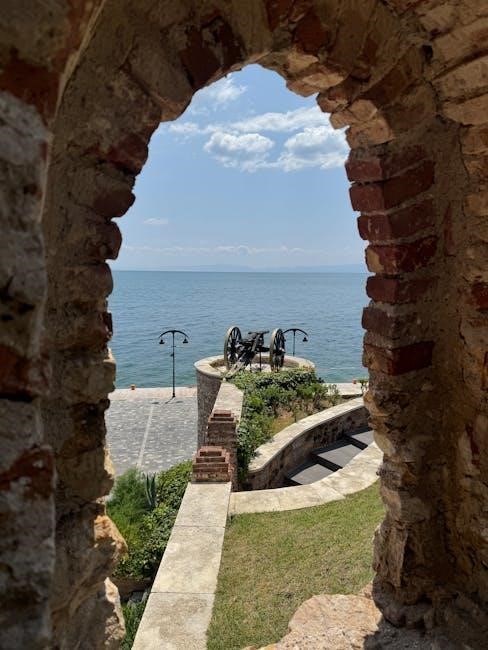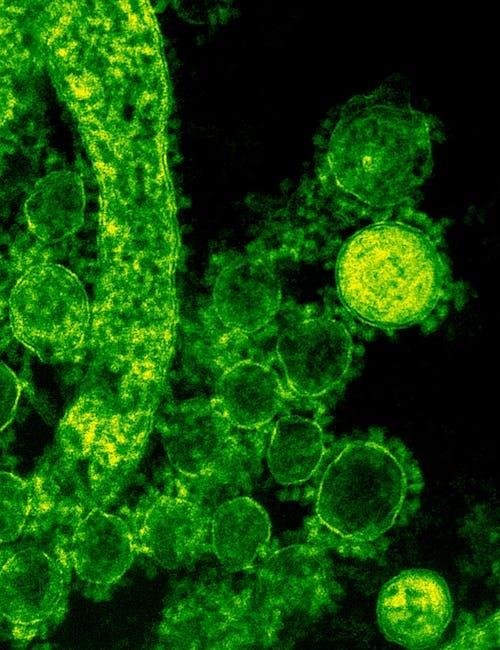The plasma membrane is the cell’s first line of defense, forming a dynamic barrier against external threats while regulating molecular transport. Composed of phospholipids, proteins, and cholesterol, it ensures cellular integrity and survival.
1.1 Overview of the Plasma Membrane
The plasma membrane is a dynamic, semi-permeable structure that encloses the cell and separates its internal contents from the external environment. Composed primarily of a phospholipid bilayer, it is a flexible yet robust barrier essential for maintaining cellular integrity. Embedded within this bilayer are proteins that perform critical functions, such as acting as receptors, channels, and transporters, enabling communication and molecular exchange. Additionally, cholesterol stabilizes the membrane, while carbohydrates attached to its surface facilitate cell recognition and signaling. This intricate structure ensures the cell’s survival by regulating what enters and leaves, making it a vital component of cellular defense and function.
1.2 Importance of the Plasma Membrane in Cell Defense
The plasma membrane serves as the cell’s first line of defense, protecting it from external threats while maintaining internal stability. Its selective permeability ensures that harmful substances are barred entry, while essential nutrients and signaling molecules are allowed to pass. This barrier function is critical for preventing invasion by pathogens and toxins. Additionally, the membrane’s ability to adapt and repair itself enhances its defensive capabilities. By regulating molecular transport and signaling, the plasma membrane plays a central role in integrating immune responses and maintaining cellular homeostasis, making it indispensable for the cell’s survival and function in hostile environments. Its dynamic nature ensures continuous protection.

Structure of the Plasma Membrane
The plasma membrane is primarily composed of a phospholipid bilayer, with embedded proteins and cholesterol, forming a dynamic and flexible structure that regulates cellular interactions.

2.1 Phospholipid Bilayer
The phospholipid bilayer forms the structural backbone of the plasma membrane, consisting of two layers of phospholipid molecules. Each phospholipid has a hydrophilic (water-attracting) head and hydrophobic (water-repelling) tails. This arrangement creates a barrier that is impermeable to most molecules, protecting the cell from external threats. The hydrophilic heads face outward, interacting with water on both sides of the membrane, while the hydrophobic tails form a nonpolar core, preventing the passage of water and polar substances. This bilayer structure is essential for maintaining cellular integrity and serves as the foundation for the membrane’s dynamic functions in defense and transport.
2.2 Membrane Proteins
Membrane proteins are integral to the plasma membrane’s structure and function, embedded within or associated with the phospholipid bilayer. They serve as receptors, channels, transporters, and enzymes, facilitating interactions with the environment. Receptor proteins bind to signaling molecules, triggering responses like immune reactions. Channel and transporter proteins regulate the movement of ions and molecules, maintaining homeostasis. Some proteins mediate cell-cell recognition, crucial for immune defense. Their diversity enables the membrane to adapt to threats while controlling substance exchange. These proteins are vital for the membrane’s dynamic role in cell defense, ensuring selective communication and protection. Their functions are essential for maintaining cellular integrity and responsiveness.
2.3 Role of Cholesterol
Cholesterol is a crucial lipid component of the plasma membrane, playing a key role in maintaining its structural integrity and fluidity. It is embedded between phospholipid molecules, where it modulates the packing of fatty acid chains, preventing the membrane from becoming too rigid or too fluid. This regulation ensures optimal membrane functionality across varying temperatures. Cholesterol also contributes to the membrane’s barrier function, helping to restrict the passage of unwanted substances. Its presence is vital for maintaining the hydrophobic core of the bilayer, ensuring the membrane’s stability and defensive capabilities. This makes cholesterol an essential component in the plasma membrane’s role as a protective and adaptive barrier for the cell.
2.4 Carbohydrates on the Membrane
Carbohydrates on the plasma membrane are primarily attached to proteins or lipids, forming glycoproteins or glycolipids. These molecules are crucial for cell-cell recognition and communication. They also play a role in immune responses, helping the immune system distinguish between the cell’s own proteins and foreign substances. The carbohydrate chains on the membrane’s outer surface act as identifiers, aiding in processes like cell signaling and adhesion. Additionally, they contribute to the membrane’s defensive capabilities by making it more resistant to certain pathogens. This outer layer of carbohydrates adds another level of protection and functionality to the plasma membrane, enhancing its role as a dynamic and adaptive barrier for the cell;

Functions of the Plasma Membrane
The plasma membrane acts as a protective barrier, regulates substance movement, facilitates cell signaling, and maintains cellular homeostasis, ensuring proper cell function and defense mechanisms.
3.1 Protective Barrier
The plasma membrane serves as a critical protective barrier, shielding the cell from external threats while maintaining internal stability. Its phospholipid bilayer structure prevents harmful substances from entering the cell, ensuring selective permeability. Embedded proteins further enhance defense by controlling molecular access. Cholesterol stabilizes the membrane, preventing excessive fluidity or rigidity. This dynamic structure adapts to environmental changes, safeguarding cellular components. By regulating what enters and leaves the cell, the plasma membrane protects genetic material and metabolic processes. Its integrity is vital for cell survival, acting as the first line of defense against pathogens and toxins. This barrier ensures the cell’s internal environment remains balanced and secure.
3.2 Selective Permeability
Selective permeability is a key function of the plasma membrane, enabling cells to regulate the movement of substances. This property ensures essential nutrients enter while waste and harmful substances are excluded. The membrane’s phospholipid bilayer, with its hydrophilic heads and hydrophobic tails, naturally restricts passage, except for small, nonpolar molecules like oxygen and carbon dioxide. Membrane proteins, such as channels and carriers, facilitate selective transport, allowing ions and larger molecules to cross through active or passive mechanisms. This controlled exchange maintains cellular homeostasis and protects the cell from external threats, making selective permeability vital for defense and survival. Interactive tools, like the “Cell Defense” game, help visualize these processes.
3.3 Cell Signaling
Cell signaling is a critical function of the plasma membrane, enabling communication between cells and their environment. Membrane receptors, such as GPCRs, bind to specific signaling molecules, triggering intracellular responses. These signals can initiate immune defenses, metabolic changes, or other protective mechanisms. The plasma membrane acts as a platform for signal transduction, ensuring proper cellular reactions to external stimuli. Interactive tools, like the “Cell Defense” game, help visualize how signaling pathways activate defense responses, making learning engaging and effective. This process underscores the membrane’s dynamic role in maintaining cellular health and defense, highlighting its importance in overall cell function.
3.4 Transport Mechanisms
The plasma membrane facilitates the transport of molecules through passive and active mechanisms. Passive transport, such as diffusion and osmosis, relies on concentration gradients and requires no energy. Active transport involves carrier proteins that move molecules against concentration gradients, using energy from ATP. These mechanisms ensure essential nutrients enter the cell and waste products are removed. Additionally, endocytosis and exocytosis enable the transport of larger molecules by forming vesicles. Interactive tools, like the “Cell Defense” game, simulate these processes, helping students understand how the plasma membrane regulates molecular movement to maintain cellular homeostasis and defense. This dynamic regulation is vital for cell survival and function.

Defense Mechanisms of the Plasma Membrane
The plasma membrane acts as a protective barrier, preventing harmful substances from entering the cell. Its selective permeability and physical structure defend against pathogens and toxins effectively.
4.1 Selective Permeability as Defense
Selective permeability allows the plasma membrane to regulate the movement of molecules, ensuring essential nutrients enter while harmful substances are blocked. This defense mechanism relies on the hydrophobic core of the phospholipid bilayer, which repels many foreign particles. Membrane proteins, such as channels and transporters, further control access by facilitating the passage of specific molecules. This dual-layered system protects the cell from toxins and pathogens while maintaining internal homeostasis. By selectively allowing substances to cross, the plasma membrane safeguards cellular functions and prevents potential threats from compromising cellular integrity. This dynamic filtering is critical for the cell’s survival and operational efficiency.
4.2 Physical Barrier
The plasma membrane serves as a robust physical barrier, shielding the cell from external damage and preventing the uncontrolled entry of harmful substances. Its phospholipid bilayer, with hydrophilic heads facing outward and hydrophobic tails inward, repels water-soluble pathogens and toxins. Embedded proteins and cholesterol enhance stability, making the membrane resistant to mechanical stress and environmental fluctuations. This structural integrity ensures the cell’s internal components remain protected, maintaining essential functions and overall cellular health. As the cell’s first line of defense, the plasma membrane’s physical resilience is vital for survival, safeguarding against external threats while preserving internal order and functionality. This barrier is indispensable for cellular well-being.
4.3 Immune Response Integration
The plasma membrane plays a critical role in integrating immune responses by serving as a platform for pathogen recognition and signaling. Membrane-bound receptors, such as Toll-like receptors and immune cell surface proteins, detect invading pathogens and trigger intracellular signaling cascades. These signals activate immune cells, initiating responses like inflammation or the production of antibodies. The membrane also facilitates communication between immune cells, ensuring a coordinated defense. Its dynamic nature allows for the recruitment of immune molecules and the formation of complexes that neutralize threats. This integration of immune signaling and response highlights the plasma membrane’s essential role in protecting the cell and maintaining organismal health.
4.4 Membrane Adaptability
The plasma membrane’s adaptability is crucial for cell survival, allowing it to adjust to environmental changes and maintain homeostasis. Its fluidity enables structural modifications, such as clustering receptors or altering lipid composition, to optimize function. Membrane proteins can be inserted or removed, enhancing responsiveness to pathogens or stress. For instance, during immune responses, the membrane can reorganize to facilitate signaling or engulf pathogens via endocytosis. This adaptability ensures the cell can defend against diverse threats while preserving its integrity. The membrane’s dynamic nature is essential for its role as a protective barrier and communication hub, making it a key player in cellular defense mechanisms.

Biological Processes Involving the Plasma Membrane
The plasma membrane facilitates essential biological processes, including molecule transport, cell signaling, and maintaining cellular integrity, ensuring proper communication and defense against external threats.
5.1 Passive Transport
Passive transport is a vital biological process where molecules move across the plasma membrane without energy input, essential for cell defense and nutrient uptake.
This includes diffusion, osmosis, and facilitated diffusion, enabling ions and nutrients to enter while waste products exit, maintaining cellular homeostasis.
5.2 Active Transport
Active transport is an energy-dependent process where molecules are moved across the plasma membrane against their concentration gradient.
This mechanism is crucial for cell defense, enabling the uptake of essential nutrients and ions, such as calcium, potassium, and sodium, against their natural flow.
Carrier proteins, fueled by ATP, bind to specific molecules and undergo conformational changes to transport them into or out of the cell.
This process ensures the cell maintains proper ion balance and internal environment, critical for signaling and metabolic functions. It contrasts with passive transport, requiring energy to counteract concentration gradients.
5.3 Endocytosis and Exocytosis
Endocytosis and exocytosis are dynamic processes that allow cells to transport large molecules, such as nutrients, hormones, and waste products, across the plasma membrane.
Endocytosis involves the membrane engulfing substances in vesicles, either through receptor-mediated pathways or phagocytosis, aiding in nutrient uptake and pathogen defense.
Exocytosis releases cellular products, like neurotransmitters or antibodies, by fusing vesicles with the membrane, crucial for communication and immune responses.
Both processes rely on membrane fluidity and energy, maintaining cellular homeostasis and defense mechanisms. These vesicle-based transports complement other membrane functions, ensuring efficient material exchange and cellular protection.
5.4 Cell Signaling Pathways
Cell signaling pathways are essential for communication, enabling cells to respond to external signals and coordinate activities. Membrane receptors, such as GPCRs and receptor tyrosine kinases, initiate signaling cascades upon ligand binding. These pathways regulate processes like immune responses, growth, and apoptosis, crucial for defense and homeostasis. Signals are transduced through second messengers, like calcium ions or cAMP, activating intracellular responses. Disruption in signaling can lead to diseases, highlighting its importance. The plasma membrane’s role in signaling underscores its dynamic nature and necessity in maintaining cellular health and defense mechanisms. Efficient signaling ensures the cell reacts appropriately to its environment.

Interactive Learning Tools
Interactive learning tools, such as The Cell Defense Game, engage users in building and repairing plasma membranes. Simulations and educational apps enhance visualization and understanding of membrane structure and function.
6.1 The “Cell Defense” Game
The “Cell Defense” game is an interactive learning tool designed to teach students about the plasma membrane’s structure and function. Players take on the role of cell defenders, tasked with building and maintaining a functional plasma membrane to protect against external threats. The game introduces key components such as phospholipids, cholesterol, and membrane proteins, allowing users to visualize how these elements work together. By progressing through levels, players learn about selective permeability, transport mechanisms, and defense strategies. The game also features a villain, Dr. Vial, whose attacks simulate real-world challenges to the membrane, making the learning experience engaging and memorable. This tool enhances understanding of cellular defense mechanisms in an immersive way.
6.2 Simulating Membrane Construction
Simulating membrane construction is a hands-on approach to understanding the plasma membrane’s structure and function. Educational apps and interactive tools guide users through building a phospholipid bilayer, adding cholesterol for stability, and incorporating proteins for functionality. These simulations often include step-by-step instructions, allowing learners to visualize how components like hydrophilic heads and hydrophobic tails arrange themselves. By engaging with these tools, students gain a deeper understanding of how the membrane protects the cell and regulates molecular transport. Such simulations are particularly effective for visual learners, making complex biological concepts more accessible and engaging. They also align with curriculum standards, enhancing classroom learning experiences.
6.3 Educational Apps for Visualization
Educational apps provide interactive and immersive ways to explore the plasma membrane’s structure and function. Popular apps feature 3D models of the membrane, allowing users to visualize phospholipid bilayers, embedded proteins, and cholesterol. Interactive simulations enable students to observe how molecules move across the membrane through passive and active transport. Quizzes and games, such as “Cell Defense,” test knowledge while making learning engaging. These tools are particularly beneficial for visual learners, helping them grasp complex concepts like selective permeability and membrane dynamics. By utilizing real-time feedback and adaptive learning, these apps enhance retention and deepen understanding of cellular defense mechanisms. They are invaluable resources for both students and educators.

Resources and Study Aids
Key resources include the Answer Key PDF, worksheets, and online flashcards. These tools provide comprehensive study materials and interactive exercises to reinforce learning about the plasma membrane.
7.1 Answer Key PDF
The Answer Key PDF provides detailed solutions to exercises and quizzes related to the plasma membrane. It covers topics like phospholipid structure, transport mechanisms, and membrane proteins. This resource helps students verify their understanding and identify areas needing review. The PDF is organized by sections, aligning with the course material for easy reference. It includes explanations for complex concepts and offers a quick way to check answers. This tool is essential for self-assessment and preparation for exams. By using the Answer Key, students can enhance their learning experience and grasp key concepts effectively.
7.2 Worksheets and Activities
Worksheets and activities provide interactive learning opportunities to engage with plasma membrane concepts. These resources include crossword puzzles, matching games, and diagram labeling exercises. Students can practice identifying membrane components like phospholipids, proteins, and cholesterol. Activities also cover transport mechanisms, such as passive and active transport, through fill-in-the-blank exercises. Some worksheets focus on simulating membrane construction, allowing students to visualize how the bilayer forms. Additionally, case studies and problem-solving scenarios help apply theoretical knowledge to real-world situations. These tools encourage hands-on learning and reinforce key concepts, making them invaluable for students seeking to master cell defense mechanisms and plasma membrane functions.
7.3 Online Flashcards
Online flashcards are a valuable study aid for mastering plasma membrane concepts. They cover key terms like “phospholipid bilayer,” “selective permeability,” and “membrane proteins.” Each card provides clear definitions and examples, making complex topics easier to grasp. Interactive features, such as multiple-choice quizzes and shuffle options, enhance engagement. Students can test their knowledge of transport mechanisms, cell signaling, and defense functions. Flashcards also include visuals, like diagrams of membrane structures, to aid retention. Accessible anytime, they are ideal for quick revision and exam preparation. This tool supports self-paced learning and helps students build confidence in understanding the plasma membrane’s role in cell defense.
The plasma membrane is crucial for cell defense, providing protection through its phospholipid bilayer and proteins. Its selective permeability and dynamic adaptability ensure cellular survival and function.
8.1 Summary of Key Points
The plasma membrane is a critical structure for cell defense, functioning as a protective barrier while regulating molecular transport. It is primarily composed of a phospholipid bilayer, with embedded proteins and cholesterol that enhance its stability and functionality. The membrane’s selective permeability allows essential nutrients to enter while blocking harmful substances; Its dynamic nature enables processes like endocytosis and exocytosis, further supporting cellular defense. Membrane proteins, including receptors and transporters, play a vital role in communication and defense mechanisms. Overall, the plasma membrane is indispensable for maintaining cellular integrity and ensuring survival in challenging environments.
8.2 Final Thoughts on Plasma Membrane Importance

The plasma membrane is the cell’s first and most critical line of defense, safeguarding the cell from external threats while facilitating essential interactions with its environment. Its dynamic structure, composed of phospholipids, proteins, and cholesterol, allows for selective permeability and active transport, ensuring the cell’s survival. By regulating the flow of materials and information, the plasma membrane plays a central role in maintaining cellular homeostasis and enabling proper functioning. Its adaptability and resilience make it indispensable for protecting the cell and facilitating its vital processes. Understanding the plasma membrane’s importance is key to appreciating cellular biology and its defense mechanisms.

References
Key sources include the “Cell Defense: The Plasma Membrane Answer Key PDF,” Quizlet flashcards on membrane structure, and studies on lipid bilayers and immune responses.
9.1 Bibliography
The “Cell Defense: The Plasma Membrane Answer Key PDF” is supported by various educational resources, including Quizlet flashcards on membrane structure and function, studies on lipid bilayers, and immune response mechanisms. Key references include “Biology 2e” for foundational concepts and “Cell Defense: The Plasma Membrane Game” instructions. Additional insights are drawn from research on membrane proteins, such as receptor-mediated signaling and transport mechanisms. Sources also include anonymous educational materials detailing phospholipid bilayers, cholesterol stabilization, and membrane adaptability. This bibliography provides a comprehensive overview of the plasma membrane’s role in cell defense, integrating both theoretical and practical knowledge for a deeper understanding of cellular biology.
9.2 Further Reading
For deeper insights into the plasma membrane’s role in cell defense, explore resources like “Cell Defense: The Plasma Membrane Game” and associated educational materials. These include detailed guides on membrane construction, transport mechanisms, and immune integration. Additional reading materials cover phospholipid bilayers, cholesterol’s stabilizing role, and receptor-mediated signaling. Worksheets, flashcards, and interactive simulations provide hands-on learning opportunities. These resources are ideal for students and educators seeking to enhance their understanding of cellular defense mechanisms and the plasma membrane’s dynamic functions in maintaining cellular health and integrity. They complement the answer key by offering practical and theoretical knowledge.
